[English] 日本語
 Yorodumi
Yorodumi- PDB-6pvn: Cryo-EM structure of mouse TRPV3-Y564A in putative sensitized sta... -
+ Open data
Open data
- Basic information
Basic information
| Entry | Database: PDB / ID: 6pvn | ||||||
|---|---|---|---|---|---|---|---|
| Title | Cryo-EM structure of mouse TRPV3-Y564A in putative sensitized state at 4 degrees Celsius | ||||||
 Components Components | Transient receptor potential cation channel subfamily V member 3 | ||||||
 Keywords Keywords | TRANSPORT PROTEIN / Ion Channels / Membrane Protein / TRP Channels | ||||||
| Function / homology |  Function and homology information Function and homology informationnegative regulation of hair cycle / TRP channels / response to temperature stimulus / positive regulation of calcium ion import / sodium channel activity / monoatomic ion channel activity / monoatomic cation channel activity / calcium channel activity / lysosome / receptor complex ...negative regulation of hair cycle / TRP channels / response to temperature stimulus / positive regulation of calcium ion import / sodium channel activity / monoatomic ion channel activity / monoatomic cation channel activity / calcium channel activity / lysosome / receptor complex / metal ion binding / identical protein binding / membrane / plasma membrane / cytoplasm Similarity search - Function | ||||||
| Biological species |  | ||||||
| Method | ELECTRON MICROSCOPY / single particle reconstruction / cryo EM / Resolution: 4.07 Å | ||||||
 Authors Authors | Singh, A.K. / McGoldrick, L.L. / Sobolevsky, A.I. | ||||||
| Funding support |  United States, 1items United States, 1items
| ||||||
 Citation Citation |  Journal: Nat Struct Mol Biol / Year: 2019 Journal: Nat Struct Mol Biol / Year: 2019Title: Structural basis of temperature sensation by the TRP channel TRPV3. Authors: Appu K Singh / Luke L McGoldrick / Lusine Demirkhanyan / Merfilius Leslie / Eleonora Zakharian / Alexander I Sobolevsky /  Abstract: We present structures of mouse TRPV3 in temperature-dependent open, closed and intermediate states that suggest two-step activation of TRPV3 by heat. During the strongly temperature-dependent first ...We present structures of mouse TRPV3 in temperature-dependent open, closed and intermediate states that suggest two-step activation of TRPV3 by heat. During the strongly temperature-dependent first step, sensitization, the channel pore remains closed while S6 helices undergo α-to-π transitions. During the weakly temperature-dependent second step, channel opening, tight association of the S1-S4 and pore domains is stabilized by changes in the carboxy-terminal and linker domains. | ||||||
| History |
|
- Structure visualization
Structure visualization
| Movie |
 Movie viewer Movie viewer |
|---|---|
| Structure viewer | Molecule:  Molmil Molmil Jmol/JSmol Jmol/JSmol |
- Downloads & links
Downloads & links
- Download
Download
| PDBx/mmCIF format |  6pvn.cif.gz 6pvn.cif.gz | 457.2 KB | Display |  PDBx/mmCIF format PDBx/mmCIF format |
|---|---|---|---|---|
| PDB format |  pdb6pvn.ent.gz pdb6pvn.ent.gz | 375.5 KB | Display |  PDB format PDB format |
| PDBx/mmJSON format |  6pvn.json.gz 6pvn.json.gz | Tree view |  PDBx/mmJSON format PDBx/mmJSON format | |
| Others |  Other downloads Other downloads |
-Validation report
| Summary document |  6pvn_validation.pdf.gz 6pvn_validation.pdf.gz | 879.4 KB | Display |  wwPDB validaton report wwPDB validaton report |
|---|---|---|---|---|
| Full document |  6pvn_full_validation.pdf.gz 6pvn_full_validation.pdf.gz | 882.6 KB | Display | |
| Data in XML |  6pvn_validation.xml.gz 6pvn_validation.xml.gz | 67.6 KB | Display | |
| Data in CIF |  6pvn_validation.cif.gz 6pvn_validation.cif.gz | 101.9 KB | Display | |
| Arichive directory |  https://data.pdbj.org/pub/pdb/validation_reports/pv/6pvn https://data.pdbj.org/pub/pdb/validation_reports/pv/6pvn ftp://data.pdbj.org/pub/pdb/validation_reports/pv/6pvn ftp://data.pdbj.org/pub/pdb/validation_reports/pv/6pvn | HTTPS FTP |
-Related structure data
| Related structure data |  20494MC  6pvlC  6pvmC  6pvoC  6pvpC  6pvqC M: map data used to model this data C: citing same article ( |
|---|---|
| Similar structure data |
- Links
Links
- Assembly
Assembly
| Deposited unit | 
|
|---|---|
| 1 |
|
- Components
Components
| #1: Protein | Mass: 92538.602 Da / Num. of mol.: 4 / Mutation: Y564A Source method: isolated from a genetically manipulated source Source: (gene. exp.)   Homo sapiens (human) / References: UniProt: Q8K424 Homo sapiens (human) / References: UniProt: Q8K424#2: Chemical | Has ligand of interest | Y | |
|---|
-Experimental details
-Experiment
| Experiment | Method: ELECTRON MICROSCOPY |
|---|---|
| EM experiment | Aggregation state: PARTICLE / 3D reconstruction method: single particle reconstruction |
- Sample preparation
Sample preparation
| Component | Name: TRPV3-Y564A in putative sensitized state at 4 degree Celsius Type: COMPLEX / Entity ID: #1 / Source: RECOMBINANT |
|---|---|
| Source (natural) | Organism:  |
| Source (recombinant) | Organism:  Homo sapiens (human) Homo sapiens (human) |
| Buffer solution | pH: 8 Details: 150 mM NaCl, 20 mM Tris-HCl, pH 8.0, 1 mM BME, 0.01% GDN |
| Specimen | Conc.: 4.07 mg/ml / Embedding applied: NO / Shadowing applied: NO / Staining applied: NO / Vitrification applied: YES |
| Specimen support | Details: unspecified |
| Vitrification | Instrument: FEI VITROBOT MARK IV / Cryogen name: ETHANE / Humidity: 100 % / Chamber temperature: 42 K |
- Electron microscopy imaging
Electron microscopy imaging
| Experimental equipment |  Model: Titan Krios / Image courtesy: FEI Company |
|---|---|
| Microscopy | Model: FEI TITAN KRIOS |
| Electron gun | Electron source:  FIELD EMISSION GUN / Accelerating voltage: 300 kV / Illumination mode: FLOOD BEAM FIELD EMISSION GUN / Accelerating voltage: 300 kV / Illumination mode: FLOOD BEAM |
| Electron lens | Mode: BRIGHT FIELD |
| Image recording | Electron dose: 57 e/Å2 / Detector mode: COUNTING / Film or detector model: GATAN K2 SUMMIT (4k x 4k) |
- Processing
Processing
| EM software | Name: RELION / Category: 3D reconstruction |
|---|---|
| CTF correction | Type: PHASE FLIPPING AND AMPLITUDE CORRECTION |
| 3D reconstruction | Resolution: 4.07 Å / Resolution method: FSC 0.143 CUT-OFF / Num. of particles: 130958 / Symmetry type: POINT |
| Atomic model building | Protocol: FLEXIBLE FIT / Space: REAL |
 Movie
Movie Controller
Controller












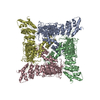
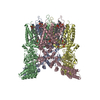
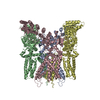
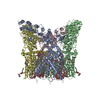
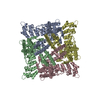
 PDBj
PDBj



